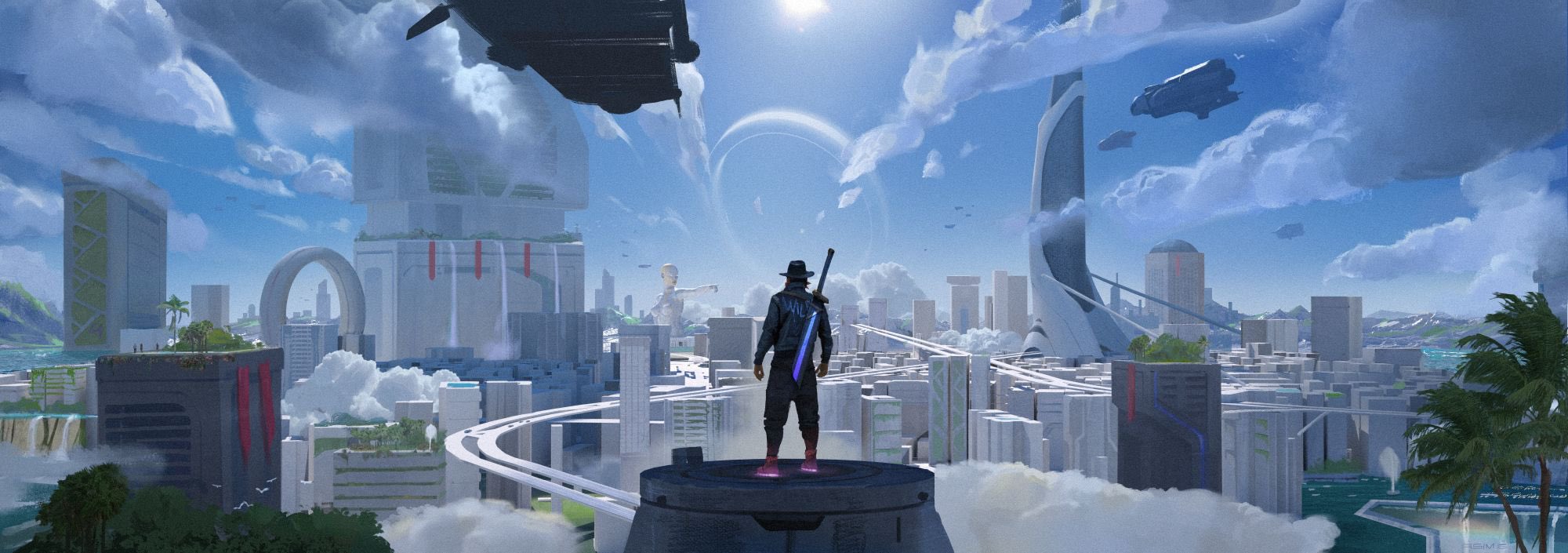Got to admit, it’s getting meta: A peer into the metaverse and the best crypto projects building it

Getty Images
Where are the best potential gains to be made in crypto this month, or into 2022? Considering the VC funding moving into it lately, it might well continue to be the “metaverse” sector – one of the buzziest buzzwords that ever buzzed.
Actually, “metaverse” has made a solid play for broader legitimacy beyond buzzword territory, making the top 10 shortlist for the Collins Dictionary’s “Word of the Year” (just beaten by “crypto” and “NFT” – the latter grabbing the top gong).
We’ll get to our list of metaversal crypto picks at the end of this article, but first… let’s wade on into a virtual swamp of information and try to figure out what the hell this metaverse thing actually is all about.
Thanks, Faceb… er, Meta
Metaverse-based crypto tokens, which now have their own categorised list on CoinGecko, have been some of the cryptocurrency market’s top performers just recently. And they largely have Facebook to thank for that.
That’s because in October, Facebook changed its name (or at least that of its parent company) to Meta – aiming to “bring the metaverse to life”.
And that means, in a 3D virtual environment, Meta will aim to connect people, build virtual communities, grow businesses… and collect and collate your personal data for the purpose of targeted advertising as it moves further towards becoming the overpowered, evil-mastermind element of a James Bond plot.
Mark Zuckerberg offers you some BBQ sauce in the Metaverse… what do you do? 🤔 pic.twitter.com/UoA68nz7La
— Ruff Past (@ruffpast) November 29, 2021
The attention the Zuck-led rebrand garnered has created a knock-on effect that’s resulted in pretty much any crypto with even the most tenuous metaverse link pumping like crazy at some point in the past month or so.
Weird little dumpling-like monster NFTs? Metaverse. A picture of dog in a Viking helmet? Metaverse. Every single sh*tcoin using the prefix “meta”? Metaverse… obvs.
Getting meta-versed, crypto style
But what is the metaverse? Stockhead‘s Eddy Sunarto wrote a great explainer last week, which included the word’s origin and noted some of the early metaverse movers in the realm of publicly listed companies.
We’re approaching it from the crypto angle, naturally, and have likewise listed a few of the most compelling decentralised metaversal crypto projects further below.
But defining the metaverse, meanwhile, isn’t the easiest thing to do. It is, after all, a pretty nebulous term and concept.
Seeing as we called out the Collins Dictionary earlier, here’s its definition:
Fair enough. So expanding on that, we think it’s a 3D, VR, AR (augmented reality), and AI-infused version of interconnected online spaces – the internet on steroids. Ready Player One, Free Guy, Tron… all that… plus, ya know… crypto.
And in terms of crypto, the majority of metaverse focused projects tend to meet at the utilitarian and aesthetically considered intersection of NFTs (non-fungible tokens), gaming, decentralised finance (DeFi) and Web3 infrastructure – which is basically the decentralised version of the internet.
There can be only one… or not?
One thing to note, you’ll likely hear and see the word being used as if there are several different metaverses – the Sandbox metaverse, the Decentraland metaverse, so-and-so is creating a metaverse for its new game… etc.
This isn’t, strictly speaking the most accurate usage, as “the metaverse” is supposedly the idea of one – and only one – exponentially growing, interconnected virtual alternate reality, in which individual worlds all inhabit an interoperable, digitised utopia. (Or dystopia, depending how many film plots you’re prepared to be influenced by.)
That concept plays into the idea of “the singularity” – the hypothetical moment “when technological growth becomes uncontrollable and irreversible, resulting in unforeseeable changes to human civilisation”.
Maybe it’s a moot point, though, because we can’t see the pluralised interpretation disappearing any time soon. Plus, you could argue that there are already at least two different types of metaverse building – the decentralised metaverse run by DAOs (decentralised autonomous organisations), and the centralised, company-controlled, Meta/Facebook-style metaverse. Who knows, though, perhaps these will bleed into one eventually.
Interest keeps streaming in
If you’re unconvinced that the metaverse is growing rapidly in the collective cultural consciousness, and that it’s going to be a dominant force in our future lives, then consider some of these recent follow-the-money news stories…
• Morgan Stanley, one of the world’s biggest investment banks, views the metaverse as “the next big investment theme”, according to a note it directed towards its investors in mid November.
“It can fundamentally change the medium through which we socialise with others,” said Morgan Stanley strategist Edward Stanley.
Morgan Stanley reports #Metaverse is a $8T opportunity Retweet this tweet if you are going to become a metaverse billionaire #GatewayToMetaverse
— DODAS (@DODAS_ACK) November 24, 2021
• Grayscale, a digital-asset-managing behemoth, released a detailed report last week in which it described the metaverse as a “trillion-dollar business opportunity”.
Particularly highlighting the gaming sector as being at the forefront of the metaversal movement, the report states:
“This vision for the future state of the web has the potential to transform our social interactions, business dealings, and the internet economy at large.”
The #Metaverse and the rising Web 3.0 paradigm are closely related trends. @David_Grid and @MattMaximo1 from our research team break down what everyone is talking about (and what it could mean for investors): https://t.co/COJhFwcPCB pic.twitter.com/VPuGVUKXbT
— Grayscale (@Grayscale) December 3, 2021
• Niantic, the developer of the once-insanely popular AR mobile game Pokemon Go, has plans to build a “real-world” metaverse. It’s already received US$300 million from prominent tech investor Coatue.
So, more people getting walking into lampposts and traffic as they roam the planet staring at at their phones… but looking for crypto? Possibly.
“Niantic is building a platform for AR based on a 3D map of the world that we believe will play a critical role in the next transition in computing,” said Coatue general partner Matt Mazzeo.
Pokemon Go Studio Goes to The #Metaverse https://t.co/md9B6pTS5D
— Crypto Rand (@crypto_rand) November 25, 2021
• Big fashion is absolutely diving in. Which was inevitable, as online worlds populated by various pixelated avatars running about flexing with Gucci, Adidas and whatever else, represents a major opportunity for brands to get in front of Gen Z audiences. Yep, the power of advertising will already be a permanent fixture and ubiquitous inside the metaverse by the time we start using it properly.
Adidas Original is doubling down on the metaverse after buying virtual land in The Sandbox and a few days after teasing a collaboration with Bored Ape Yacht Club, Punks Comic and GMoney. Their website hints at a potential drop on Adidas Confirmed. pic.twitter.com/4l8FfLuesl
— Hypegeek® (@hypegeekpod) December 2, 2021
Gaming and the metaverse
Crypto gaming is, undoubtedly, the sub-sector that is truly leading the way for the development of the metaverse and its ecosystem at this point in time.
Some blockchain-based gaming protocols (such as Decentraland and The Sandbox) in particular have been pioneers in this regard. A nod has to be given to what’s inspired them, however, including the likes of World of Warcraft, Second Life, Minecraft and other vast virtual worlds.
One of the things that really gives blockchain-based gaming worlds an edge or point of difference, though, is the emergence and utility of NFTs (non-fungible tokens). It means that, for the first time, gamers can have total ownership over in-game items – digital-world assets… be it digital clothing, land, property, vehicles, art, music… the list goes on.
ENTER THE SNOOPVERSE 🥂 @SnoopDogg is coming to the #Metaverse and he's bringing some friends to the party!
🔸 Wave 1: Dec 2nd
🔸 122 LANDs
🔸 67 Premium LANDs (+ exclusive #NFTs)
🔸 3 ESTATE auctionshttps://t.co/smHhznRmwY#TSBxSnoopDogg @CozomoMedici @NipseyHussle pic.twitter.com/1SPIGrskSb— The Sandbox (@TheSandboxGame) December 1, 2021
So, add that sense of real-world value and ownership to the fundamentals of decentralised, user/community-governed spaces, and it puts blockchain-based gaming metaverse projects on another level economically and socially, compared to the walled gardens that have gone before them.
Top metaverse crypto picks
Finally then, let’s get a sense of a couple of the highly regarded and established plays in the crypto metaverse sector right now… As well as some that could be flying under your radar, and might have greater investment potential for higher returns if the bull market sustains a while longer.
(Note: it’s best to also DYOR and take into consideration various factors, such as tokenomics, team, reputation, investors and roadmap, to get a true sense of each project.)
1. Decentraland
Token: MANA
Market cap: US$5.7 billion
Website: decentraland.org
If it isn’t the OG crypto virtual world, Decentraland was definitely one of the first, and is one of the most influential and referenced metaverse projects in the space. It’s a decentralised (as its name suggests) 3D virtual-reality platform that consists of 90,601 parcels of land that can be explored, built upon and roamed by digital avatars.
Virtual estates, items and avatars in Decentraland are NFTs which can be bought by the project’s native currency MANA, which is an ERC20 (Ethereum-based) token.
Part of the reason Decentraland is a leader in the space is due to a sense of first-mover advantage and an established dedicated network of users building and meeting virtually in its locations for the past few years, through conferences, games, concerts, galleries and more.
The @dcllandbot having fried its circuits, we’re pleased to officially announce the largest metaverse land purchase ever! Congrats to @tokens_com and @Metaverse_Group for securing a 116 parcel estate in the DCL fashion precinct. And if you’re in the fashion industry – get ready! pic.twitter.com/IGyb4nbZQW
— Decentraland (@decentraland) November 23, 2021
Taking part in the Decentraland world is affordable – free even, at its most basic level of engagement.
Obtaining land, however, isn’t cheap – unless you were clever enough to get in on its initial land sale a few years ago and pick up a few plots for US$20 each. The floor (lowest) price for a small parcel of land now is about 3.25 ETH (about US$15,00), while one digital estate recently sold for an obscene amount – US$2.4 million.
In fact, obtaining land in most of these top projects is an expensive exercise once they’ve been established for some time. The trick is obviously to get in super early on quality projects and their land sales, if at all possible. That’s much easier said that done, however.
Graphically, the Decentraland world is highly stylised in a somewhat toony sense, and might seem a little rudimentary to some at this stage, although that’s not to say that aspect can’t be, and won’t be, modified over time.
2. The Sandbox
Market cap: US$5.9 billion
Website: sandbox.game
Like MANA, the SAND token shot up in value to the tune of about 400 per cent in the weeks after Facebook officially rebranded to Meta.
The Sandbox is a highly creative gaming universe that has similar aesthetics to Minecraft and has managed to reel in more than 40 million people so far. It’s a world where users can create, buy, sell and trade in-game digital assets – including plots of blocky digital land.
Acquired by Animoca Brands in 2018, which has since become a venture capitalist beast in the crypto gaming sector, The Sandbox has raised several multi-million dollar funding rounds led by the likes of investment giants such as Softbank among others.
As with Decentraland and virtually all other metaverse projects, The Sandbox land owners can build on top of their digital plots and create gaming experiences and/or host events such as concerts and private parties – something Snoop Dogg is already planning.
The current floor price for a plot of LAND in The Sandbox is similar to Decentraland’s, currently about 3.2 ETH at the time of writing.
3. Wilder World
Market cap: US$429 million
Website: wilderworld.com
The token for this building digital universe is currently sitting outside the top 200 on the crypto market cap lists, meaning it has a lot more room to grow than the first two on our list. That’s not to say it will, of course, but Wilder World looks to have plenty going for it, including some impressive backing.

Utilising the advanced Unreal Engine 5 game-development suite, this project differentiates itself from the first two in its aim to create photo-realistic immersion as a core part of its experience.
According to the Hackernoon writer Bart Hillerich, who sounds like Wilder World’s number one fan in this in-depth article on the project: “if you’ve been looking for the real-life Ready Player One, you’ve found it”.
https://www.youtube.com/watch?v=_lo9843uZQw
Wilder World’s ambition is vast. Its grand design is to create a galaxy of worlds and cities and locations, beginning with its first city – Wiami, which has been fast selling out its initial NFT “Cribs” (condos), “Wheels” (drivable and playable NFT vehicles) and AirWILD kicks (shoes).
Some of the big financial backers for this one include Digital Currency Group, Spartan Group and Animoca Brands.
4. Netvrk
Market cap: US$202 million
Website: netvrk.co
Another relatively low-cap project, Netvrk (pronounced Network) self describes as “a social virtual world and platform with powerful creation tools and infrastructure to easily create, share and experience and monetise creation”.
Netvrk is pretty similar to Wilder World, in that it’s going for a more realistic vibe than the cartoony, pixelated worlds of Decentraland and The Sandbox.
It, too, is using Unreal Engine 5 to create realistic-looking spaces – with a strong focus on VR-technology compatibility, as well as enabling its own economy of in-game, in-world assets and sandbox-style creation mechanics (watch this trailer to get a feel for those).
The project’s list of investors is long, but its list of partners is probably even more impressive, with more than 70 blockchain companies listed on its website apparently willing to help build out and populate the Netvrk world. A good sign for potential growth and adoption.
5. Axie Infinity
Market cap: US$7.6 billion
Website: axieinfinity.com
Axie Infinity is the OG NFT battler Pokemon-stye game that has led the charge on the surging GameFi, or play-to-earn trend.
It has a simplistic aesthetic and simplistic gameplay, but that might be part of the reason it’s captured the attention of more than 1.8 million daily users (on a good day) and more than US$3.54 billion in total sales volume.
Axie plays into the concept of the metaverse because it is also an open, decentralised world in which players can buy, own, sell and trade land and other assets.
6. Illuvium
Market cap: US$850 million
Website: illuvium.io
Illuvium is an Aussie-founded NFT sci-fi battler that is also building in a vast, open-world role-playing game element, based around NFT asset and land ownership.
The game aims to bring AAA-quality to the blockchain-gaming space and has been actively collaborating with various other gaming and metaverse projects as it continues to build – including Wilder World. You can read a bit more about it in our Q&As with its founder Kieran Warwick here… and here.
Keep an eye out for the game’s first land sale in early 2022. Not financial advice, but land sales in hot-ticket, popular games with huge communities (and Illuvium fits that bill), have proven to be pretty lucrative pick-ups for some.
7. Metahero
Market cap: US$1.08 billion
Website: metahero.io
An ambitious project that calls itself “the gateway into the metaverse”, Metahero is essentially creating the largest possible database it can of scanned objects and people, using 3D scanning and modelling technology.
And that’s all with the aim of generating ultra-realistic 3D avatars and digital items to be used within realistic VR worlds, such as Netvrk, for instance.
Metahero’s tech also apparently allows for the creation of NFTs from real-world works of art and collectibles.
https://www.youtube.com/watch?v=T-kOuNePMPo
8. Star Atlas
Market cap: US$295 million
Website: staratlas.com
Star Atlas is another high-profile (in the cryptoverse at least), sci-fi-themed, play-to-earn game with vast, multi-world scope and big ambitions.
Building on Solana, the game has a dual-token GameFi economy (the ATLAS utility token, and the POLIS governance/DAO token) and is a sweeping, RPG space-strategy game set in the year 2,620. (Wonder what BTC, ETH and SOL will be worth in 600 years, incidentally…)
In development and being released in stages, the game will be set up for players to hunt, obtain, trade and create various NFTS within its universe, including spaceships of various size and value. Some of these are available for to buy now.
Yield Guild Games has apparently been purchasing about US$1 million worth of the game’s assets, including rare “Calico Guardian” spaceships, which have been selling for as much as US$45,000.
As you can see from the trailer, above, Star Atlas, like Illuvium, is taking the AAA, cinematic-quality approach, and is using Unreal Engine technology to do so.
Related Topics
UNLOCK INSIGHTS
Discover the untold stories of emerging ASX stocks.
Daily news and expert analysis, it's free to subscribe.
By proceeding, you confirm you understand that we handle personal information in accordance with our Privacy Policy.








